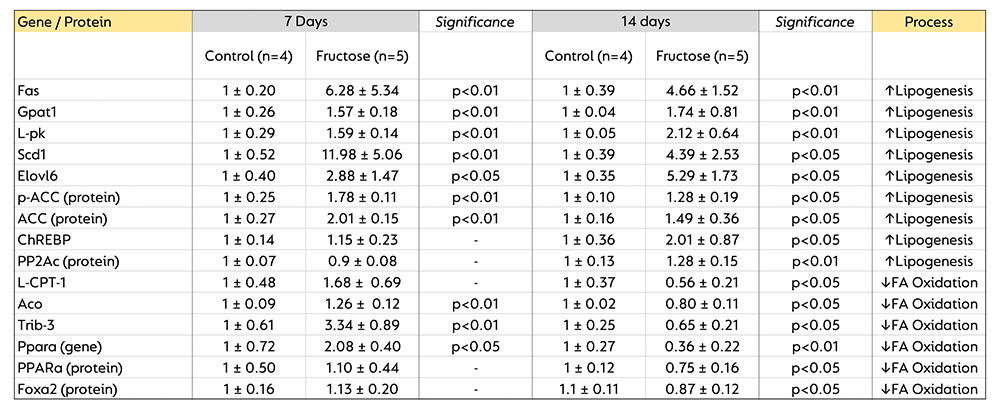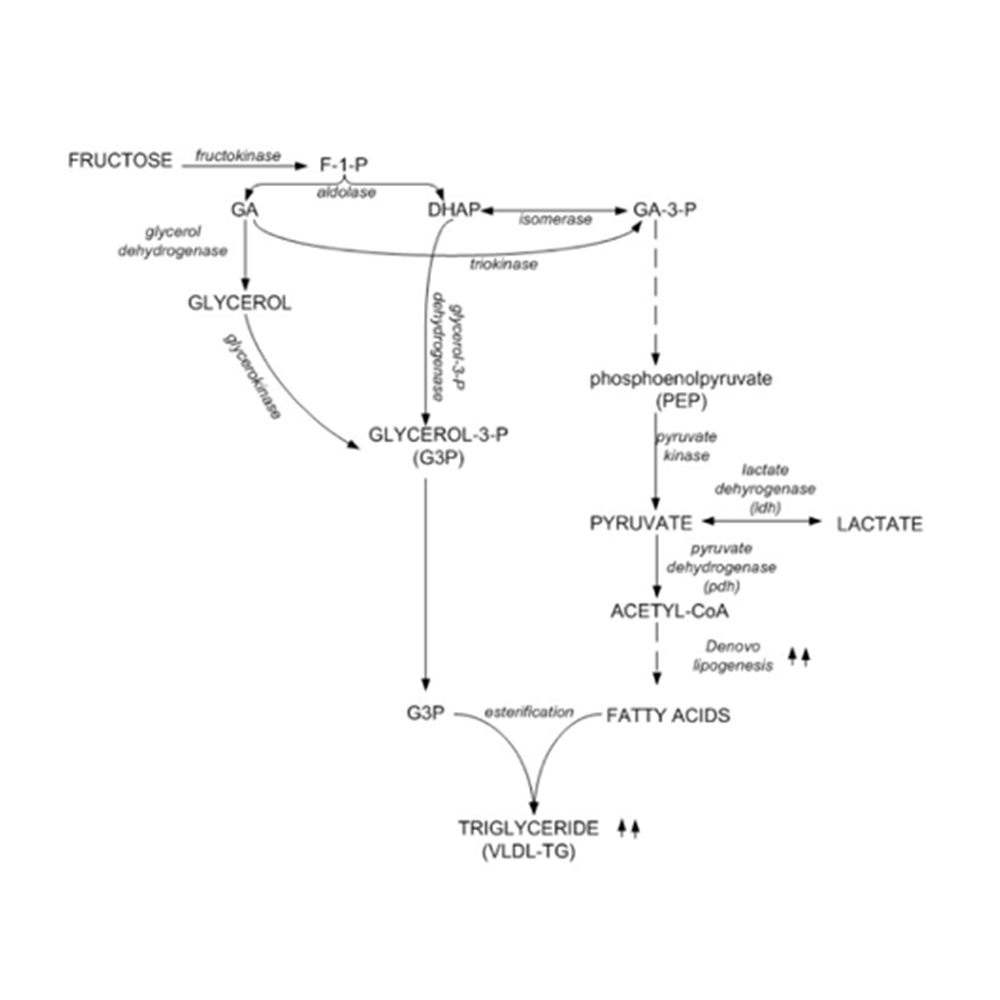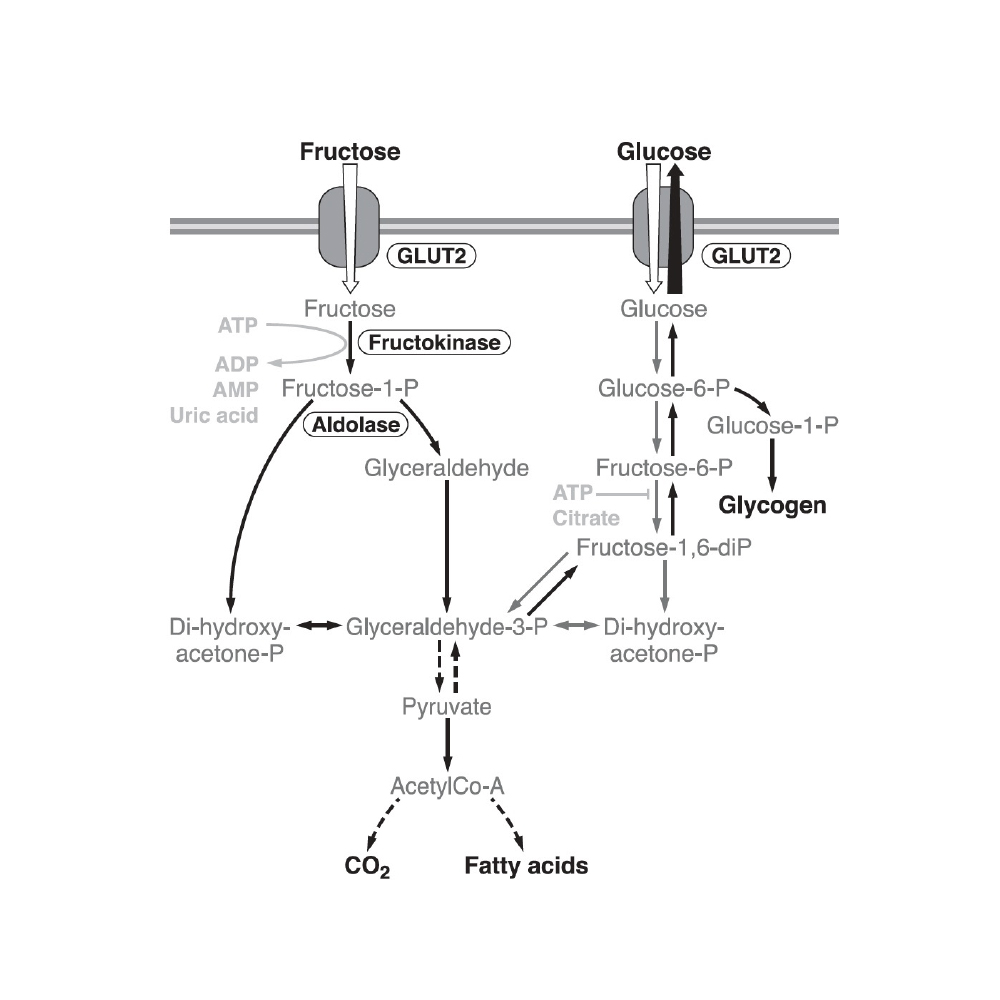Understanding Fructose
First Principles
To understand fructose well, let’s start from first principles: how is it metabolised, how does its metabolism differ from glucose, and what are the implications?
Fructose Metabolic Pathway = damaging positive feedback loop, energy depletion and cellular stress
Key Points
FRUCTOSE METABOLISM & ITS CONSEQUENCES
- Fructose is metabolised by the small intestine, kidneys, skeletal muscle and adipose tissue, although the majority of excess fructose is metabolised by the liver, with a similar pathway to alcohol (ethanol), i.e. as a toxin. Research indicates that amounts >30g fructose for an adult weighing 60kg leads to rapid pressure upon the liver to deal with the fructose, wherein it goes through the pathway described below that has many negative consequences, not only upon liver function: inducing non-alcoholic fatty liver disease over time (i).
- As shown above, fructose enters the cell (via GLUT2) and is metabolised by fructokinase into Fructose-1-P. This first step in fructose metabolism reduces ATP (the main energy carrier in the body) and creates uric acid (UA) (ii). Increasing UA in the body has harmful effects, including increasing blood pressure, disrupting the immune system and increasing cardiovascular disease risks (iii).
Harmful Fat
Fructose and Harmful Fat Creation
- The fructose metabolic pathway leads to de novo lipogenesis: fat generation (i).
- Fructose metabolism also has epigenetic effects that switch on fat storage and suppress fat burning (ii, iii).
- Fructose leads to increased visceral fat accumulating between / around organs, especially around the waist. This type of fat tissue is harmful and disrupts the functioning of those organs (particularly the pancreas and the liver) (iv, v, vi, vii).
Turns on Fat Creating
Fructose
Turns on Fat Creating (Lipogenic) and Turns off Fat Burning (FA-Oxidation) Genes and Proteins

Fructose-supplementation increases liver weight and triglycerides. Fructose-supplementation upregulates lipogenic genes and proteins while downregulating FA-oxidation genes and proteins.
Rebollo, A. et al. (2014) ‘Liquid fructose downregulates Sirt1 expression and activity and impairs the oxidation of fatty acids in rat and human liver cells’, Biochimica et Biophysica Acta – Molecular and Cell Biology of Lipids, 1841(4), pp. 514–524
Makes us hungry
WE EAT MORE
FRUCTOSE CONSUMPTION: INCREASES GHRELIN: the HUNGER hormone, this causes LEPTIN resistance and the FULLNESS hormone STOPS WORKING.
- Fructose consumption activates the endocannabinoid system: makes us crave more dopamine-releasing, highly energy-dense foods (more sugary foods).
Gut Health
Fructose, Sucrose and Gut health
Fructose alters the composition and metabolism of gut microbiota and is causally associated with colitis (chronic inflammation of the colonic internal lining) and inflammatory bowel disease (i).
Fructose induces epithelial barrier (intestinal lining) dysfunction (ii). The intestinal lining is one of the most critical interfaces in our bodies, responsible for absorbing nutrients and keeping toxins and pathogens out of the body. Its health and optimal functioning is thus critical to our digestion, energy generation and immune system function (a large percentage of our immune cells surround the gut). When there is any abnormal functioning and/or intestinal permeability, these essential functions are likely to become disrupted, resulting in inflammatory, autoimmune, allergic and/or malabsorption problems and disease.
View MoreImmune System
Fructose, Sucrose & Immune Dysfunction
Dietary sugars, especially fructose, negatively impact the innate immune system, in multiple ways, including by significantly inhibiting the binding of pattern recognition molecules, a critical step that initiates immune signaling cascades. This reduces the immune system’s defense against both viral and bacterial pathogens. Research demonstrates that this is the case in a dose-dependent manner (i.e. the more fructose ingested, the worse the effect) (i).
Sucrose increases the risk of allergic inflammation in the lungs, and higher sugar intake is associated with asthma. (ii, iii)
View MoreSkin
Fructose and skin
Sugar (fructose and sucrose) consumption leads to increased production of advanced glycation end products (AGEs) in the body, including in the skin. These cross-linked sugar-proteins reduced the ability of the skin to heal and regenerate, thus accelerating the formation of wrinkles and general skin ageing (i, ii, iii, iv, v, vi).
Fructose leads to a reduction in the anti-inflammatory hormone adiponectin, and lower levels of adiponectin in subcutaneous adipose tissue (fat tissue beneath the skin) is associated with cellulite in those areas. Cellulite is also linked to glycation, another risk factor for cellulite (vii, viii).
View MoreMental Health
Fructose and Mental Health
Sugar (sucrose and fructose) impacts the brain negatively. Via various mechanisms, it may increase the risk of depression (i) and have other detrimental brain health consequences, including increasing the risk of and accelerating the pathophysiology of neurodegenerative disorders such as Alzheimer’s disease (ii, iii).
A high sugar diet has been linked to cognitive impairment, including hippocampal dysfunction and negative neuroplasticity (iv, v, vi).
Fructose reduces blood flow to numerous important brain regions (vii) and interferes with the function of dopamine, a key hormone in regulating motivation and mood (viii).
View MoreChronic Diseases
Fructose and Chronic Diseases
High fructose consumption has adverse impacts on various tissue structures and organ functions, and indirectly and directly plays a role in the pathophysiology of various chronic diseases.
High sugar and fructose intake directly contribute to the development of Type 2 diabetes, obesity and hypertension.
Fructose has been demonstrated to be a causal factor in tumour growth in colorectal cancer, particularly when fructose is ingested in liquid form (i).
Fructose plays a role in pancreatic cancer growth, as the pancreatic cancer cells specifically utilise fructose metabolism to fuel the creation of nucleic acids, the building units of RNA and DNA, to enable the cancer to grow (ii).
View MorePractical
What amount is ok? How can I see?
What amounts of fructose are problematic, and how can I check nutrition labels to avoid overconsuming it?
Exactly how much fructose, over what durations, and in what forms (liquid forms are very problematic) are pathological? Recent research demonstrates that even levels of c. 0.25g/kg body weight per day (e.g. 15g of fructose per day for a 60kg person) can be harmful (i). This is equivalent to a small glass (150ml) of apple juice. A typical ‘date ball’ snack on the market has >15g of sugar (50% of which is fructose), so two of these will put you over this level. True, date balls have some fibre, typically c. 3g per ball, but on balance, the fibre content therein is unlikely to offset fructose’s negative health consequences.
View More

